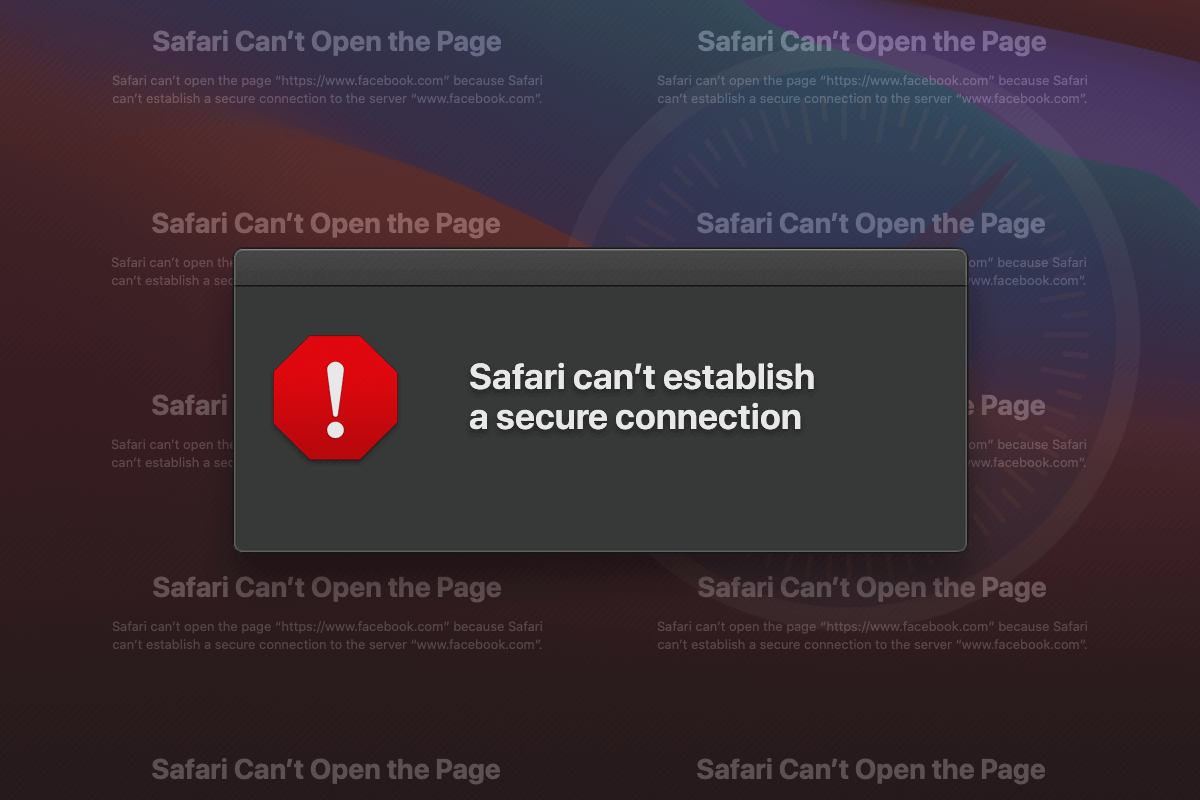Safari is a popular web browser developed by Apple and is widely used on both Mac and iOS devices. However, like any other browser, Safari is not immune to issues that can hinder your browsing experience. One common issue that users may encounter is when Safari cannot open a page and cannot establish a secure connection. This can be frustrating, especially if you need to access a specific website or perform online tasks.
There can be several reasons why Safari is unable to establish a secure connection. In this article, we will explore some of the possible causes and provide you with six methods to fix this issue.
1. Clear Safari Caches:
Clearing your browser data, including the cache and cookies, can help resolve various browsing issues. To clear Safari caches on your iPhone or Mac, follow these steps:
– On iPhone: Go to Settings > Safari > Clear History and Website Data.
– On Mac: Open Safari, go to Safari menu > Preferences > Privacy > Manage Website Data > Remove All.
2. Set the Correct Date and Time:
An incorrect date and time on your device can cause issues with SSL certificates, which are required for secure connections. To ensure the correct date and time settings, follow these steps:
– On iPhone: Go to Settings > General > Date & Time. Enable the “Set Automatically” option.
– On Mac: Click on the Apple menu > System Preferences > Date & Time. Enable the “Set date and time automatically” option.
3. Check the Web URL:
Sometimes, the issue may not be with Safari itself but with the website you are trying to access. Double-check the web URL to ensure it is correct and does not contain any typos or errors.
4. Update Your Device:
Updating your iPhone or iPad to the latest iOS version or your Mac to the latest macOS version can help resolve compatibility issues and improve the overall performance of Safari. To update your device, follow these steps:
– On iPhone: Go to Settings > General > Software Update.
– On Mac: Click on the Apple menu > System Preferences > Software Update.
5. Reset iPhone Settings:
If none of the previous methods worked, you can try resetting your iPhone settings. This will not erase your data but will reset settings such as network, privacy, and other preferences. To reset your iPhone settings, go to Settings > General > Reset > Reset All Settings.
6. Disable Browser Extensions and Add-ons:
Browser extensions and add-ons can sometimes interfere with the secure connection process. Try disabling or uninstalling any recently installed extensions or add-ons to see if it resolves the issue.
It is important to note that these methods may not work in all cases, as the issue can be specific to certain websites or network configurations. If the problem persists, you may need to contact the website’s administrator or seek further technical assistance.
When Safari cannot open a page and cannot establish a secure connection, it can be frustrating. However, by following the steps outlined in this article, you can troubleshoot and resolve the issue in most cases. Remember to clear Safari caches, check your device’s date and time settings, verify the web URL, update your device, reset settings if necessary, and disable any conflicting browser extensions or add-ons.

Steps to Resolve Safari Cannot Open The Page Because It Could Not Establish a Secure Connection to The Server
To resolve the issue of Safari not being able to open a page due to a failure in establishing a secure connection to the server, you can follow these steps:
1. Clear your browser data: Start by clearing your browser data, including the cache and cookies. This helps in removing any corrupted or outdated data that might be causing the issue.
2. Check device’s date and time: Make sure that the date and time settings on your device are correct. Incorrect settings can sometimes create conflicts with SSL certificates and prevent a secure connection.
3. Change DNS settings: Try changing your DNS (Domain Name System) settings to a different server. This can be done in your device’s network settings. Sometimes, using a different DNS server can resolve connection issues.
4. Uninstall or disable browser extensions and add-ons: Some browser extensions or add-ons can interfere with the secure connection process. Disable or remove any recently installed extensions and check if the issue persists.
5. Disable IPv6: In some cases, disabling IPv6 on your device can help establish a secure connection. You can do this in your network settings or preferences.
6. Ensure Keychain trusts the SSL certificate: Open Keychain Access on your Mac and check if the SSL certificate for the website you are trying to access is trusted. If not, mark it as trusted to establish a secure connection.
By following these steps, you should be able to resolve the issue of Safari not being able to establish a secure connection to the server.
How Do You Allow Safari to Establish a Secure Connection?
To allow Safari to establish a secure connection, you can follow these steps:
1. Clear Safari caches on your device: This can help resolve any issues caused by corrupted or outdated cache files. On an iPhone or iPad, go to Settings > Safari > Clear History and Website Data. On a Mac, open Safari, go to the Safari menu, and select Clear History.
2. Set the correct date and time: Incorrect date and time settings can sometimes cause issues with secure connections. Make sure your device’s date and time are set accurately. On an iPhone or iPad, go to Settings > General > Date & Time. On a Mac, go to System Preferences > Date & Time.
3. Check if the web URL is correct: Ensure that you are typing the correct web address or URL in the Safari address bar. Sometimes, a simple typo can prevent the secure connection from being established.
4. Update your iPhone or iPad: Outdated iOS versions can potentially cause issues with secure connections. Check if there are any available software updates for your device and install them. Go to Settings > General > Software Update to check for updates.
5. Reset iPhone settings: If the above steps do not work, you can try resetting your iPhone or iPad settings. Note that this will erase your personalized settings but not your data. Go to Settings > General > Reset > Reset All Settings. Confirm the action and enter your device passcode if prompted.
If none of these steps solve the issue, it may be helpful to contact Apple Support or your internet service provider for further assistance.
What to Do When It Says Cannot Establish a Secure Connection?
When you encounter the error message “This site can’t provide a secure connection,” it means that your browser is unable to establish a secure connection with the website you’re trying to access. This can be due to various reasons, but there are several steps you can take to fix the issue:
1. Install an SSL Certificate: An SSL certificate is necessary to establish a secure connection between a website and the user’s browser. If the website you’re trying to access doesn’t have an SSL certificate, you can contact the website owner or administrator and request them to install one.
2. Force an HTTPS Connection: You can manually type “https://” instead of “http://” before the website URL to force your browser to establish a secure connection. This may bypass any issues with the website’s default connection settings.
3. Reinstall the SSL Certificate: If you’re the website owner or administrator, you can try reinstalling the SSL certificate. This can be done through your web hosting provider or SSL certificate provider. Make sure to follow the installation instructions carefully.
4. Reset the SSL Cache and Clear Browser Cache: Clearing your browser’s cache and resetting the SSL cache can help resolve any temporary issues with stored data. Instructions for clearing the cache can vary depending on the browser you’re using, so consult the browser’s settings or preferences menu for the appropriate steps.
5. Turn off the QUIC Protocol Support: QUIC (Quick UDP Internet Connections) is a protocol developed by Google to enhance website loading speed. However, it can sometimes interfere with secure connections. You can disable QUIC protocol support in your browser’s advanced settings or flags section to see if it resolves the error.
6. Check the Date and Time Settings: Incorrect date and time settings on your device can cause SSL certificate verification issues. Ensure that your device’s date and time settings are accurate and adjust them if necessary.
By following these steps, you can troubleshoot and fix the “This site can’t provide a secure connection” error message. However, if the issue persists, it may be best to contact your web hosting provider or seek professional assistance to resolve the problem.
Conclusion
Safari is a popular web browser used by many individuals and organizations. However, there are instances when users may encounter issues with establishing a secure connection while browsing certain websites. This can be frustrating and hinder the overall browsing experience.
Fortunately, there are several methods that can be employed to fix the “Safari can’t establish a secure connection” issue. These methods include clearing browser data such as cache and cookies, checking device’s date and time settings, changing DNS settings, disabling browser extensions and add-ons, disabling IPv6, and ensuring that Keychain trusts the SSL certificate.
By following these steps, users can address the issue and ensure a secure browsing experience. It is important to note that Safari displays a warning when a website is not secure, indicating potential risks to users. This warning may be triggered if a website’s certificate is expired or illegitimate.
Furthermore, if users encounter the “This site can’t provide a secure connection” error, there are additional steps that can be taken to resolve it. These include installing an SSL certificate, forcing an HTTPS connection, reinstalling the SSL certificate, resetting the SSL cache and clearing browser cache, and checking the date and time settings.
It is crucial to address these security-related issues promptly to protect personal information and ensure a safe online environment. Safari, with its wide range of features and user-friendly interface, remains a popular choice for browsing the internet, and by following the necessary steps to fix secure connection issues, users can continue to enjoy a seamless browsing experience.








